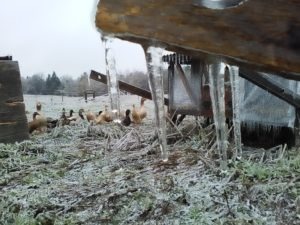Winter in Ohio can be a bleak affair. I find myself bundled, two pairs of pants on, slogging through some fresh snow at what feels like too early on a Saturday morning. As I walk, I take notice of my surroundings. The one-acre annual garden looks kind of lumpy covered in snow.
There’s nothing green to be seen and without the bright purple sign and my prior knowledge, I’m not sure I would think about this place as a farm.
 I eventually reach my destination of the chicken coops. I turn off the electric fence and hop over, wishing I had taken time to find my gloves. I hear the chickens, ducks, and geese squawking and honking, excited to be fed. I quickly locate their food troughs, turn them over, and fill them so I can let the poultry out. I open the coop door and they all charge forward. I get a sense of excitement seeing their energy and forget about my slowly damping feet and cold fingers and start watching them. I’m slowly learning to recognize each bird as an individual. There’s the oldest duck, slightly bigger than the rest, and there’s the shy little chicken with the yellow spot on its face. One of the geese will make eye contact with me now, in a way that it knows me and isn’t as afraid as the others. I feel close to it, like it is the beginning of a relationship. This feeling of total involvement is one I feel often on the Farm.
I eventually reach my destination of the chicken coops. I turn off the electric fence and hop over, wishing I had taken time to find my gloves. I hear the chickens, ducks, and geese squawking and honking, excited to be fed. I quickly locate their food troughs, turn them over, and fill them so I can let the poultry out. I open the coop door and they all charge forward. I get a sense of excitement seeing their energy and forget about my slowly damping feet and cold fingers and start watching them. I’m slowly learning to recognize each bird as an individual. There’s the oldest duck, slightly bigger than the rest, and there’s the shy little chicken with the yellow spot on its face. One of the geese will make eye contact with me now, in a way that it knows me and isn’t as afraid as the others. I feel close to it, like it is the beginning of a relationship. This feeling of total involvement is one I feel often on the Farm.
Over the winter, it seems like there isn’t a lot that goes on at the Farm. This is somewhat true when you compare the work to the rest of the year, but some of the most important work gets done during this time. Two big yearly projects are peeling the garlic harvested for out kitchen staff to use and the plant nursery.
The plant nursery is where we begin many of the plants that are grown over the summer. Everything is started from seed in the nursery and  it is one of my favorite projects.This year many seeds were planted outside of our normal annual crops. We will be using these plants to start a sheep apothecary, medicinal native plant garden, and migration justice butterfly garden. Our Sheep Apothecary and Native Medicinal Garden will be full of plants that can be used for health, whether they be put into a tea, tincture, pr salve, for humans or fed to the sheep.
it is one of my favorite projects.This year many seeds were planted outside of our normal annual crops. We will be using these plants to start a sheep apothecary, medicinal native plant garden, and migration justice butterfly garden. Our Sheep Apothecary and Native Medicinal Garden will be full of plants that can be used for health, whether they be put into a tea, tincture, pr salve, for humans or fed to the sheep.
 We hope this garden will be a place where people will have a chance to meditate on migrating beings affected by the wall, whether they be human or animal.
We hope this garden will be a place where people will have a chance to meditate on migrating beings affected by the wall, whether they be human or animal.
The Migration Justice Garden is full of plants that help attract and sustain butterfly larva. It is being built in solidarity with the National Butterfly Center on the Mexico border, which is projected to be greatly impacted as Trump’s proposed border wall is constructed, as well as other efforts to support asylum seekers and migration justice.
I love holding each of these seeds and feeling them before planting. I imagine each one as different as I place them into the soil and wonder what they will look like. I cannot wait to see them germinate; see their life and how they grow and how each is unique. Having this space for connection to our food source and the land is one of my favorite parts of working on the Antioch Farm.
Katie Sherman ’19 is a fourth-year Antioch Student and holds one of the Miller Fellow Crew Leader positions on the Antioch Farm. She is working on a self design major in Environmental Science titled “the environment in the anthropocene : a science of connection.” She is also the leader of Antioch’s Outdoor Club.



